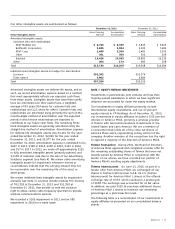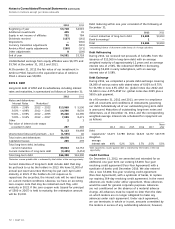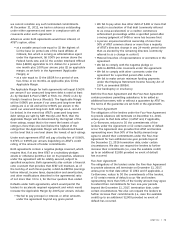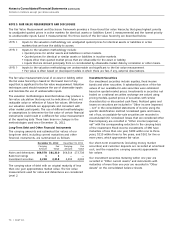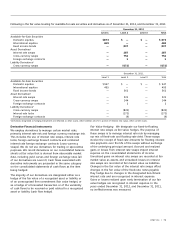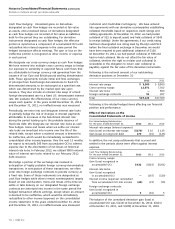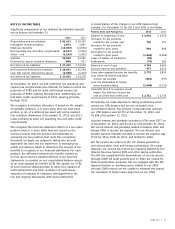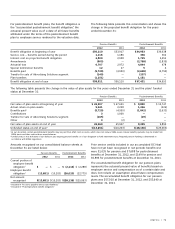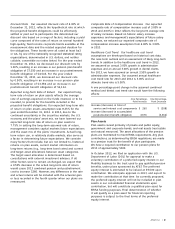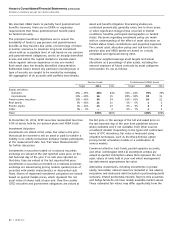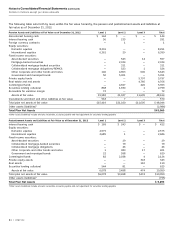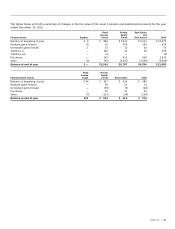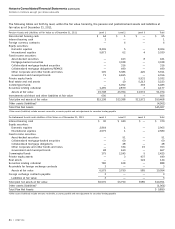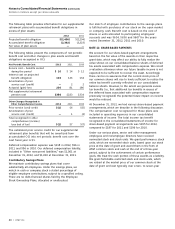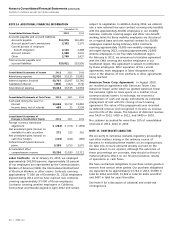AT&T Wireless 2012 Annual Report Download - page 83
Download and view the complete annual report
Please find page 83 of the 2012 AT&T Wireless annual report below. You can navigate through the pages in the report by either clicking on the pages listed below, or by using the keyword search tool below to find specific information within the annual report.
AT&T Inc. | 81
Composite Rate of Compensation Increase Our expected
composite rate of compensation increase cost of 3.00% in
2013 and 4.00% in 2012 reflects the long-term average rate
of salary increases. Based on historic salary increase
experience and management’s expectations of future salary
increases, we reduced our expected composite rate of
compensation increase assumption from 4.00% to 3.00%
in 2013.
Healthcare Cost Trend Our healthcare cost trend
assumptions are developed based on historical cost data,
the near-term outlook and an assessment of likely long-term
trends. In addition to the healthcare cost trend in 2012,
we assumed an annual 3.00% growth in administrative
expenses and an annual 3.00% growth in dental claims.
For 2013, we have assumed an annual 2.50% growth in
administrative expenses. Our assumed annual healthcare
cost trend rate for 2013 and 2012 is 5.00% and our
ultimate trend rate is 5.00%.
A one percentage-point change in the assumed combined
medical and dental cost trend rate would have the following
effects:
One Percentage- One Percentage-
Point Increase Point Decrease
Increase (decrease) in total of
service and interest cost components $ 260 $ (208)
Increase (decrease) in accumulated
postretirement benefit obligation 3,676 (3,362)
Plan Assets
Plan assets consist primarily of private and public equity,
government and corporate bonds, and real assets (real estate
and natural resources). The asset allocations of the pension
plans are maintained to meet ERISA requirements. Any plan
contributions, as determined by ERISA regulations, are made
to a pension trust for the benefit of plan participants.
We have a required contribution to our pension plans for
2013 of approximately $300.
In October 2012, we filed an application with the U.S.
Department of Labor (DOL) for approval to make a
voluntary contribution of a preferred equity interest in our
Mobility business to the trust used to pay qualified pension
benefits, under plans sponsored by AT&T. The preferred
equity interest is estimated to be valued at $9,500 upon
contribution. We anticipate approval in 2013, and expect to
make the contribution at that time. As currently proposed,
the preferred equity interest will not be included in plan
assets in our consolidated financial statements upon
contribution, but will constitute a qualified plan asset for
ERISA funding purposes. Final determination of whether
it will qualify as a plan asset for financial reporting
purposes is subject to the final terms of the preferred
equity interest.
Discount Rate Our assumed discount rate of 4.30% at
December 31, 2012, reflects the hypothetical rate at which
the projected benefit obligations could be effectively
settled or paid out to participants. We determined our
discount rate based on a range of factors, including a yield
curve composed of the rates of return on several hundred
high-quality, fixed income corporate bonds available at the
measurement date and the related expected duration for
the obligations. These bonds were all rated at least Aa3
or AA- by one of the nationally recognized statistical rating
organizations, denominated in U.S. dollars, and neither
callable, convertible nor index linked. For the year ended
December 31, 2012, we decreased our discount rate by
1.00%, resulting in an increase in our pension plan benefit
obligation of $7,030 and an increase in our postretirement
benefit obligation of $4,546. For the year ended
December 31, 2011, we decreased our discount rate
by 0.50%, resulting in an increase in our pension plan
benefit obligation of $3,384 and an increase in our
postretirement benefit obligation of $2,114.
Expected Long-Term Rate of Return Our expected long-
term rate of return on plan assets reflects the average
rate of earnings expected on the funds invested, or to be
invested, to provide for the benefits included in the
projected benefit obligations. Our expected long-term rate
of return on plan assets assumption was 8.25% for the
year ended December 31, 2012. In 2013, due to the
continued uncertainty in the securities markets, the U.S.
economy and the plans’ asset mix, we have lowered our
expected long-term rate of return on plan assets to
7.75%. In setting the long-term assumed rate of return,
management considers capital markets future expectations
and the asset mix of the plans’ investments. Actual long-
term return can, in relatively stable markets, also serve as
a factor in determining future expectations. We consider
many factors that include, but are not limited to, historical
returns on plan assets, current market information on
long-term returns (e.g., long-term bond rates) and current
and target asset allocations between asset categories.
The target asset allocation is determined based on
consultations with external investment advisers. If all
other factors were to remain unchanged, we expect that
a 0.50% decrease in the actual long-term rate of return
would cause 2013 combined pension and postretirement
cost to increase $260. However, any differences in the rate
and actual returns will be included with the actuarial gain
or loss recorded in the fourth quarter when our plans are
remeasured.


